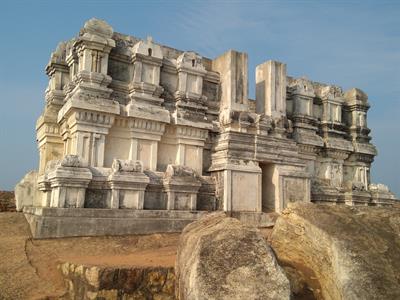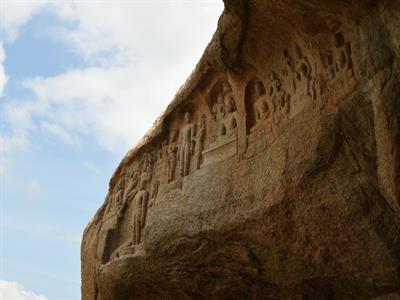PDF chapter test TRY NOW
Tamilnadu and its Jain connection
- The division of sects within Jainism marked the advent of Jain principles to the southern part of India. This marked the slow spread of the Ideas and principles of Jainism in Tamilnadu and other parts of its neighbouring states.
- According to the Sangam literature and other texts, many kings had widely mentioned the influence exerted by the Jainist monks on the rulers of Tamil kingdoms as they gave patronage to various monks during their reign.

Jain temple in Tamilnadu
- The Northern part of Tamilnadu is where the researchers believed that the tradition of Jains flourished. Some of the places where Jain concentration was witnessed,
1. Vellore
2. Vilupuram
3. Kanchipuram
4. Thanjavur
5. Madurai
Literary Sources regarding Jainism
- The Tamil – Brahmi inscriptions dating back to the 3rd Century BCE had details regarding the livelihoods of Jain in Tamilnadu.
- The Sangam Literature mentions Jain people as “Seminars”, where a hill in Madurai was named under them as “Samanar Malai”, where they believed to have existed.
PANDAVAR PADUKKAI: These are caves of Jain people located in Madurai (Kalinjamalai hill). It is believed to be the bed of five Jain saints who stayed there for a long time.
- The Kalabhras who ruled the Tamil Nadu during the 3rd – 7th Century BCE were the Patrons of Jainism. The Pallava kings, who were the followers of the Hindu religion, also Patronized Jainism.

Jaina caves at Madurai
- The Trilokanatha temple in Kanchipuram was built by Pallava rulers, which had Jain edicts. Also, the Sittanavasal cave temples in Kanchipuram, which signify Jain culture was built by the rulers of the Pandyan dynasty
MANIMEGALAI: An ancient Tamil epic written in the 2nd century by the Buddhist poet “Seethalai Saththanar” had mentioned Aravor Palli, the living place of Jain monks in Tamilnadu.
- The Jain monasteries are also found in places like Puhar, Madurai, Vanchi and Mannargudi.
- Silapathikaram, an ancient epic of Tamil literature, was written by Jain monk Ilango Adigal who also mention “Gownthi Adigal” (A Female Jain monk) who accompanied the travel of the lead pair Kovalan and Kannagi.
JINA KANCHI: Considered as the seat of South Indian Digambara Jainism. A village named Thiruparthikundram in Kanchipuram was also once known as “Jina Kanchi”.
Reason for the spread of Jainism in India
- Usage of common and colloquial languages to spread the ideals of Jainism.
- The Iconic personality of Mahavira and his knowledge attracted more people towards the religion.
- The simple doctrines of Jainism easily appealed to the masses comparable to other doctrines that prevailed during that period.
- Patronage by the mighty kingdoms and trade class took the religious principles to the root of the society.
- The intellectual teachings of Jain monks and their humble nature took the spread of Jainism to greater heights.
